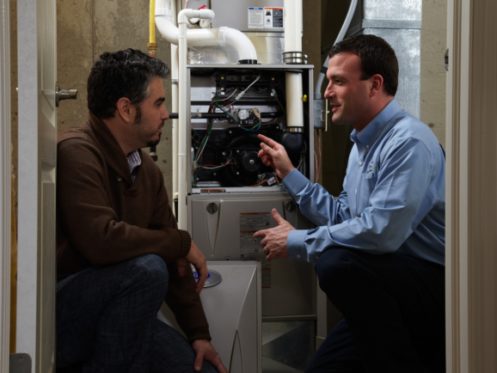The freezing Missouri winters mean that frozen pipes are a fairly common problem. If your plumbing does ever freeze, you will want to take steps to start thawing out the pipes immediately. Your pipes will eventually thaw on their own, but this will take at least a few hours or potentially several days, depending on where the pipe is located and the air temperature around it. Let’s now take a look at why you shouldn’t wait to thaw out your pipes, how to thaw them out more quickly and also what steps you can take to prevent your plumbing from freezing.
Why You Should Never Wait for Frozen Pipes to Thaw Naturally
If one of your pipes freezes, it will result in little to no water flowing out of some or potentially all of your plumbing fixtures. This means that you may not have any access to water until the pipe finally thaws out. Nonetheless, the main reason that you should never wait for a frozen pipe to thaw naturally is that it greatly increases the risk of the pipe bursting and flooding your home.
Most water lines are made from copper pipes, which are quite susceptible to rupturing should they freeze. Although copper is a fairly soft metal, it is still rigid enough that it can easily burst or break if too much pressure is applied. The reason that frozen copper pipes burst is that the water inside them expands as it turns into ice. This causes it to take up more space and applies additional pressure on the pipe. If the water completely freezes, the ice will expand to the point where the pipe bursts.
For this reason, it is important that you always pay attention during the winter and watch out for signs that may indicate you have a frozen pipe. If you do suspect that you have a frozen pipe, you will want to immediately try to locate it and then take steps to quickly thaw it out before it can freeze to the point where it bursts.
Locating a Frozen Pipe
Unfortunately, locating a frozen pipe isn’t always easy since most of your water lines run inside your walls and ceilings. As a result, you will usually need to enlist the help of a professional plumber to locate the frozen pipe and thaw it out. That being said, there are some times when you can find the frozen pipe on your own or at least narrow down the search area to make it easier for the plumber to locate it.
The most obvious sign that you have a frozen pipe somewhere in the home is if there is very little water pressure in one or more plumbing fixtures. If any pipe is completely frozen, then no water will come out of the fixture. If you notice this issue, the first thing to do is check every one of your plumbing fixtures to see if the problem is isolated or throughout the entire home.
If you only have low or no water pressure in one fixture or one room, this makes it much easier to pinpoint the approximate location of the frozen pipe. For instance, if only your kitchen sink has issues, it means that either the cold or hot water pipe underneath your sink is frozen. Many people mistakenly think that hot water pipes can’t freeze, but they definitely can. If you’re not currently using any hot water, the water inside the pipes will quickly start to cool and may potentially get cold enough to freeze.
If all of your plumbing fixtures are affected, it means that the main water line is frozen somewhere near your water meter. If all of your fixtures will work when turned to cold but no water flows when you turn on the hot water, it means that the hot water pipe is frozen somewhere near your water heater. If only part of the home is affected, it means that the branch line in your basement or crawlspace that feeds that part of the home is frozen.
How to Thaw Out Frozen Pipes More Quickly
If you do manage to locate the frozen pipe, you have a few different options for thawing it out quickly and safely. The easiest way to thaw a pipe underneath a sink or in another easily accessible location is to use a space heater to warm the pipe quickly. You can also thaw out a pipe by using a hair dryer or by wrapping the frozen section in an electric heating pad.
The thing that you should never attempt to do is use a blow torch or any other type of flame to thaw out the pipe. This is far too much heat for the copper pipe to handle and will usually end up weakening or damaging the pipe to the point where it starts to leak. This will obviously create a much more serious and costly problem since you will then need to hire a plumber to replace the damaged section of the pipe.
Steps for Preventing Your Pipes From Freezing
One of the easiest ways to prevent your pipes from freezing is to always leave your heating on during the winter, and your thermostat set no lower than 60 degrees. Even if the temperature in the main part of the home is 55 degrees, the areas inside your exterior walls or in your basement or crawlspace will be far colder and can easily drop to the point where the water inside your pipes starts to freeze.
This is especially true if you have any gaps or cracks where air can seep in from the outside, which is why you should also make sure that your home’s exterior and your basement/crawlspace are well sealed. You should also make sure that any water lines that run through your basement, attic or crawlspace are fully wrapped with pipe insulation or heat tape since these areas are often much colder.
During extremely cold weather, you should also take two additional steps to help ensure that your pipes can’t freeze. The first is to open up the cabinet doors underneath all of your sinks. This will allow warmer air to circulate around the pipes and can be a huge help in preventing the pipes from freezing.
The second thing to do is to open up all of your plumbing fixtures so that there is just a trickle of water running. This will ensure that there is some water constantly flowing through your pipes. If the fixtures are closed, the standing water inside the pipe can easily freeze, whereas running water is far less likely ever to freeze.
Your home’s heating system is your main line of defense against frozen pipes, which makes it essential that the system is working properly and keeping your home sufficiently warm. Should you have any issues with your heating system, you can trust the team at Level 9 Heating, Cooling, and Plumbing for help. We repair all types of heating systems, and we also offer professional heating maintenance and repair services. Our team also installs and services air conditioners, geothermal HVAC systems and indoor air quality equipment. If you need any residential or commercial HVAC service in Washington, St. Louis or the surrounding areas, give Level 9 Heating, Cooling, and Plumbing a call today.



